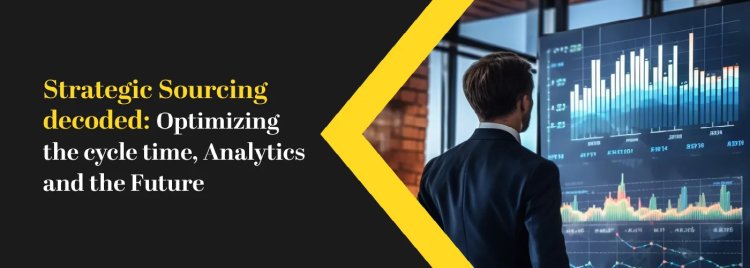Strategic Sourcing Decoded - Optimizing the Cycle Time, Analytics and Future
However, amidst this transformation, one critical aspect often overlooked is the potential of data analytics services to optimize the strategic sourcing cycle.
Share this Post to earn Money ( Upto ₹100 per 1000 Views )

In the realm of procurement, the once traditional functions of sourcing, purchasing, and procurement are undergoing a metamorphosis. No longer relegated to mere cost centers, these departments are emerging as strategic powerhouses driving innovation, mitigating risks, and delivering tangible value to the bottom line of organizations. However, amidst this transformation, one critical aspect often overlooked is the potential of data analytics services to optimize the strategic sourcing cycle.
Decoding Strategic Sourcing for Efficiency Gains
Strategic sourcing, at its core, is the art of navigating the journey from requisition to purchase with maximum efficiency. Therefore, it's about more than just securing the best price; it's a proactive approach to meeting market demands, reducing costs, and navigating industry upheavals. But before delving deeper, let's distinguish between two major approaches: Tactical/Operational Sourcing and Strategic Sourcing.
Tactical Sourcing focuses on short-term gains, addressing immediate transactional needs. So, in contrast, Strategic Sourcing serves as the grand orchestrator, aligning procurement strategies with broader organizational objectives such as supplier relationships, risk management, and innovation. Moreover, for the purpose of this discussion, we zoom in on the criticality of Strategic Sourcing processes.
Key Components Determining the Strategic Sourcing Cycle
-
Forecasting and Categorization
Analyzing historical and projected purchasing data lays the groundwork for understanding spending patterns across various categories. So, prioritizing categories based on criticality, complexity, and volume ensures efficient allocation of sourcing efforts and resources.
-
Category Strategy
Aligning sourcing strategies with organizational goals involves considerations like cost reduction, innovation, and risk mitigation. Therefore, techniques such as multi-criteria decision analysis (MCDA) optimize supplier selection and negotiation, driving strategic alignment.
-
Category Execution
Operationalizing the chosen category strategy requires integrated data platforms for visibility into inventory levels, supplier performance, and compliance adherence. So, AI algorithms enable adjustments based on changing demand patterns, ensuring seamless execution.
-
Supplier Selection
Therefore, developing evaluation criteria specific to organizational needs, including metrics like price, quality, and delivery times, ensures objective supplier comparison. Weighted scoring models facilitate the shortlisting of promising candidates.
-
Negotiation and Contracting
Identifying suppliers offering competitive rates, innovation, and technical expertise lays the foundation for successful negotiations. Formalizing agreements with clear terms and performance guarantees solidifies supplier partnerships.
Challenges with Traditional Sourcing Process
While the importance of optimizing sourcing cycle time is evident, traditional procurement tools often fall short in streamlining the process efficiently. So, these challenges underscore the need for advanced capabilities, particularly in data analytics.
Data analytics offers a competitive edge in strategic sourcing
To achieve true efficiency in the purchasing process, organizations must embrace data-driven decision-making. Let's explore how data analytics revolutionizes each facet of strategic sourcing:
-
Need Identification
Historical data analysis enables accurate demand forecasting, initiating the sourcing process proactively and eliminating manual tasks.
-
Dynamic Demand Forecasting
Predictive analytics streamlines sourcing by ensuring goods and services are available precisely when needed.
-
Precision in Supplier Selection
Comprehensive data enables meticulous, data-driven supplier selection based on performance metrics, financial stability, and market intelligence.
-
Material Price Optimization
Advanced data management and forecasting models allow businesses to extract insights, predict future price trends, and optimize total cost of ownership.
-
Monitoring and Improvement with Data-Backed KPIs
Continuous monitoring of KPIs offers insights into process strengths, weaknesses, and market dynamics, facilitating corrective actions and a culture of improvement.
-
Empowering Sourcing Personnel
Data analytics empowers personnel with the skills and knowledge for data-driven decision-making, fostering ownership and problem-solving capabilities.
-
Risk Mitigation and Compliance Assurance
Dynamic risk assessment frameworks evaluate supplier stability, geopolitical factors, and compliance adherence, fortifying supplier relationships against disruptions.
Analyzing the Future of Strategic Sourcing
Looking ahead, strategic sourcing will evolve with advancements in technology and changing business landscapes. Embracing AI, automation, sustainability, and collaboration will be key for future success.
Wrapping Up
The strategic sourcing cycle is pivotal for operational efficiency in procurement. Moreover, data analytics acts as a catalyst, optimizing each stage of the sourcing process and leading to reduced cycle times and improved efficiency. Embracing data-driven approaches, including leveraging data analytics services in Hyderabad, is no longer an option but a necessity for organizations striving to stay ahead in today's competitive landscape.
Frequently Asked Questions (FAQs)
1. What distinguishes Strategic Sourcing from Tactical Sourcing?
Ans. Strategic Sourcing emphasizes aligning procurement strategies with broader organizational objectives, focusing on enduring supplier relationships, risk management, and innovation. In contrast, Tactical Sourcing addresses immediate transactional needs with a shorter-term perspective.
2. How does data analytics contribute to Strategic Sourcing efficiency?
Ans. Data analytics plays a pivotal role in Strategic Sourcing by enabling accurate demand forecasting, meticulous supplier selection, material price optimization, continuous monitoring of key performance indicators (KPIs), and empowering personnel with data-driven decision-making capabilities.
3. What challenges do organizations face with traditional sourcing processes?
Ans. Traditional sourcing processes often lack the advanced capabilities required for efficient cycle time optimization. So, these challenges include manual tasks, inaccurate demand forecasting, suboptimal supplier selection, and inadequate risk management and compliance assurance.
4. What are some future trends in Strategic Sourcing processes?
Ans. Future trends in Strategic Sourcing include the integration of advanced analytics with AI and blockchain, a focus on sustainability and resilience in supplier selection, and fostering collaboration and innovation through deep partnerships with key suppliers and platform-based sourcing.
5. Why is embracing data-driven approaches essential for procurement success?
Ans. Embracing data-driven approaches is essential for procurement success as they enable organizations to optimize sourcing processes, reduce cycle times, improve efficiency, and stay competitive in today's rapidly evolving business landscape.














